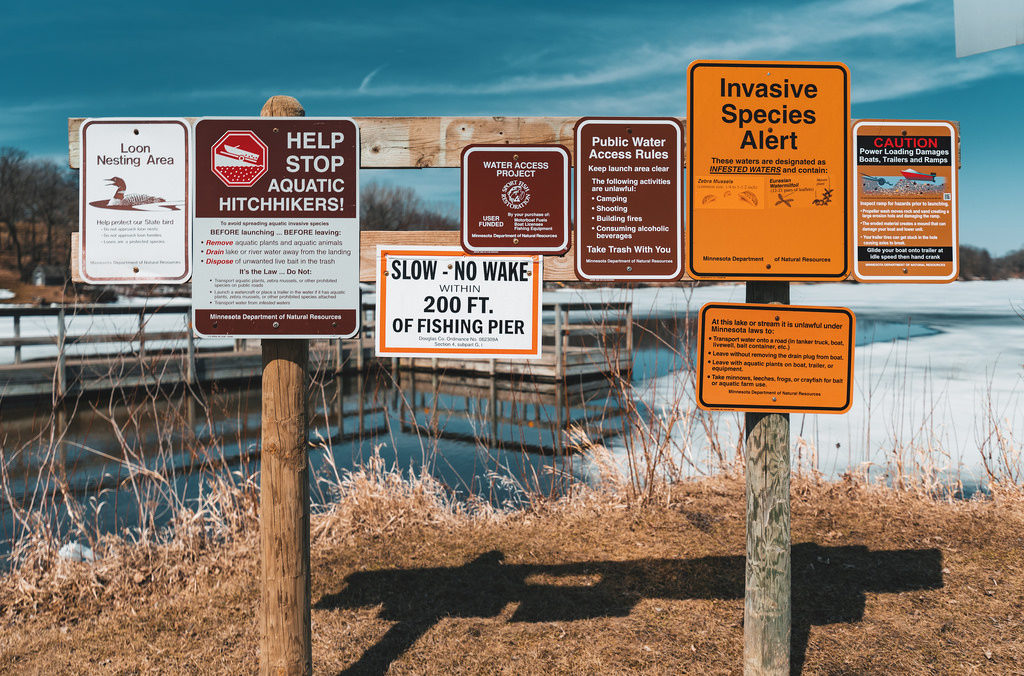
Stop Invasive Species: 10 Things You Can Do
Subscribe to our weekly newsletter to stay up-to-date on the latest invasive species news and to receive opportunities to take action. Be sure to share this list with your friends and family in need of a nudge, a reminder, or a back-to-basics invasives education.
1. Clean, Drain, and Dry
We know, cleaning your boat or watercraft is a drag. But lace up your Nikes and Just Do It™. Depending on which state or province you live in or are visiting, you might even be legally obligated! Rinse off any vegetation and let completely air dry before launching in a different body of water. This rule applies to your pet pooch as well!
2. Love Your Pet Fish (‘Til Death Do You Part)
Your goldfish or guppy may look cute, small, and innocent, but she doesn’t belong in your backyard North American stream or lake. Goldfish, for example, have been found to grow as long as 16 inches and weigh up to four pounds in the wild. They’re ecological tornadoes that uproot vegetation, disturb sediment, breed excessively, release algae-feeding nutrients, eat everything in sight, AND transmit disease and parasites. Bubbles the goldfish doesn’t look so innocent anymore, does she?
Many marine invasions have been traced back to releases of aquarium pets into the wild. If you can no longer care for your aquatic pets, find a trusted friend, family member, or to accept the responsibility. Never (and we *mean* never) release pets into the wild.
3. Use Local Firewood
The health of waterways often depends on the health of surrounding terrestrial environments. Changes in forest composition and shoreline flora can have tremendous impacts on water. Firewood can contain parasites and bugs like the emerald ash borer, Asian longhorned beetle, and European gypsy moth that can decimate North American forests.
We all enjoy a good bonfire, but don’t be *that* person—source firewood locally when you travel.
4. Go Fishing (With Native Bait)!
69 out of 180 aquatic invasive species in the Great Lakes region are fish. One primary mode of entry is the improper use and disposal of fishing bait. Use native species if you decide on live bait.
Oh, and never dump unused bait into the water after you’ve packed up your rod and boonie hat.
5. Wash Your Hiking, Camping Gear
Dirt isn’t the only thing you can carry from place to place. The moment you brush past a plant or set your pack in a meadow, you’re inviting seeds to cling to your belongings. Brush and clean your gear to prevent spreading seeds, spores, plants, and insects.
6. Learn to Identify Invasive Plant Species in Your Area
Research invasive species in your neck of the woods, travel to your favorite water body, document any invasive plants, and report them! Many states, local governments, and community organizations have online resources to help. Check out this site by the State of Michigan as an example.
Invasive species should be reported using the Midwest Invasive Species Information Network (MISIN) online reporting tool or the MISIN smartphone app. Alternately, these species can be reported to the Cooperative Invasive Species Management Area for your region or your local conservation district.
7. Crossing the Border? No, You Can’t Take It With You
Leave plants, seeds, and fruits behind.
8. Volunteer As a Monitor
Basically the same as #6 on this list, but formally through a local community group. Join an existing one, or form your own! This is a great way to reach and involve more folks in your community and democratize the preservation of your local waterways. Community groups can provide training, formal reporting processes, and safe invasive species removal.
9. Plant Native Species In Your Garden and Yard
Before you head to the local nursery, figure out some basic information on your backyard. Soil type? Average precipitation? Sun exposure? Drainage pattern? Slope? Figure out in which “ecoregion” you reside using this USDA Forest Service map. Check your “plant hardiness zone.” Provide this information to nursery staff when you arrive, or utilize it when researching on your own. Your local library, government websites, and non-profit/NGO sources are great places to start.
Native species have the benefit of being adapted to environmental conditions of your area. Say goodbye to the days of excessive watering, fertilization, pesticide application, mowing, and pruning! Native plants and alternative, native-plant yards are as close to maintenance free as you can get. As a bonus, you’ll help preserve local pollinators, beneficial insects, birds, small mammals, and other wildlife. All of these benefits have positive spillover effects on your local waterways.
10. Get Political
We live in a society that cares a lot about what individuals should do, so much so that we often forget to talk about what individuals can do together. Politics isn’t a dirty word; it’s a way of negotiating how things are done in society. Preventing the tremendous disruption human activity often brings to our Great Lakes ecosystems requires personal habits to change AND collective political action. Call your legislators at the local, state, and federal levels; tell them you care about preventing invasive species. Visit office hours of elected officials. Get involved with local prevention groups. Contribute to advocacy organizations working every day to maintain the integrity of our native ecosystems.